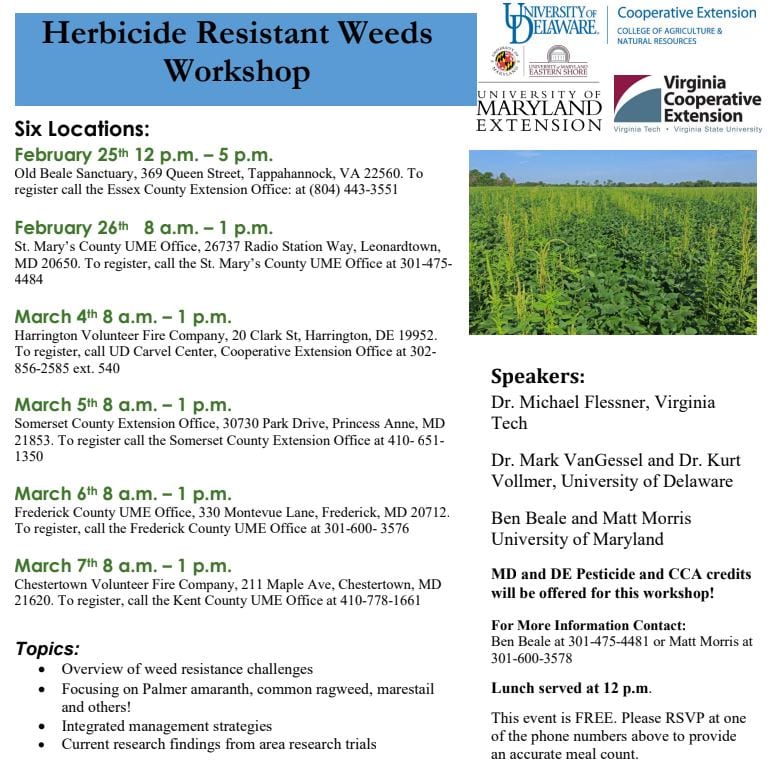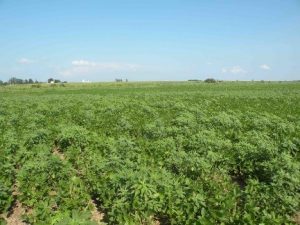Kelly Hamby and Galen Dively
University of Maryland, Department of Entomology
Insect Resistance Management in Bt Crops: Transgenic crops expressing insecticidal toxins sourced from Bacillus thuringiensis (Bt) bacteria reduce yield loss and insecticide use, delivering economic benefits for growers. Because this breakthrough in pest management is considered a public good and insect resistance is the largest threat to Bt crops’ durability, insect resistance management programs were developed and mandated by the EPA prior to the release of Bt crops. These plans included planting untreated refuge crops at high enough acreage to produce many susceptible adult insects that could interbreed with and dilute the resistance from insects surviving Bt crops (Figure 1).

In addition, crops were supposed to express Bt toxins at a high enough dose that insects with diluted resistance genes (white and red) would be killed, called a “high dose” strategy. Finally, pyramided hybrids that contain multiple toxins targeting the same pest were developed to make it more difficult for pests to overcome the toxins. EPA also required monitoring for insect resistance and mitigation strategies to implement once resistance was detected.
The Issue: When best management practices for Bt insect resistance management are followed, for example, European corn borer (Ostrinia nubilalis) management in the U.S., resistance development has been slowed. In fact, all single and pyramided Bt traited corn hybrids still provide 100% control of corn borers. However, for some pests [corn earworm (Helicoverpa zea) and Cry toxins] Bt toxins were less effective and products were not high dose. This issue was further compounded by poor refuge compliance, which lead to the development of refuge-in-a-bag (RIB) seed mixes to increase refuge acreage. This technology was designed based on corn rootworm biology and is not as good as a separate block refuge for most other target pests. Finally, while pyramided multi-toxin hybrids were developed, hybrids that contained a single effective toxin for the management of some pests continued to be marketed. This enables insects to develop resistance to a single toxin first providing a “stepping stone” to resistance in pyramided hybrids that contain the same or similar toxins because they can already survive on some of the toxins that are being expressed. In addition, the same Bt toxins are used in both corn and cotton, so corn earworm (also known as bollworm) goes through multiple generations of selection pressure in the same year, increasing resistance. Reports of caterpillar pests resistant to Bt corn and cotton in the U.S. have occurred since 2014 for fall armyworm, since 2016 for corn earworm, and since 2017 for western bean cutworm. However, none of these resistance reports triggered EPA’s current regulatory definition of pest resistance and no mitigation actions were taken. Therefore, the EPA released a draft document outlining proposed changes to reduce resistance risks (especially for non-high dose pests at heightened risk of resistance), to increase the longevity of currently functional Bt traits and future technologies, and to improve the current caterpillar pest (Lepidopteran) resistance management program for Bt corn and cotton (USEPA 2020).
Proposed Changes: Changes build off current insect resistance management plans and incorporate feedback and recommendations developed by a July 2018 Scientific Advisory Panel, independent academic scientists, the Agricultural Biotechnology Stewardship Technical Committee, the National Alliance of Independent Crop Consultants, and Syngenta Crop Protection, LLC (USEPA 2020). The EPA has 1) confirmed Bt resistance to specific Bt toxins in corn earworm, fall armyworm, and western bean cutworm, 2) proposed a new resistance definition for non-high dose pests that acknowledges their heightened risk of resistance and enables more rapid response to unexpected injury, 3) proposed a resistance monitoring approach that will use sentinel plots to monitor unexpected injury in addition to reported cases of unexpected injury in Bt crops, 4) proposed an improved resistance mitigation strategy with best management practices to respond to unexpected injury within the growing season and moving forward, and 5) will continue to require reporting on refuge compliance, unexpected injury, and insecticides targeting the pests that are also targeted by Bt (USEPA 2020).
Changes Under Discussion: In addition to the above changes, three additional changes have been proposed that require further discussion and stakeholder comment (USEPA 2020). The first focuses on reducing the acreage of products that no longer effectively manage resistant caterpillar pests and that share or have similar toxins as multi-toxin pyramided hybrids that still provide control. Therefore, the EPA is proposing a short term (~ 3 year time frame) phase down of hybrids that contain a single toxin for control of caterpillar pests, capping acreage planted in these hybrids to a minimum. These include field corn (Table 1), sweet corn (Table 1), and cotton products. In addition, non-functional pyramids that do not contain effective toxins for control of resistant caterpillar pests would have a longer term (~ 5 year time frame) phase down to minimal acreage (Table 2). Even with the potential phase downs Cry toxins will still be available for planting in pyramided hybrids that include the Vip3A trait.
To improve refuge compliance nationwide, the EPA proposes to increase refuge-in-the-bag (RIB) seed blend technologies to 10% refuge and maintain current requirements to plant a separate 20% block refuge in cotton producing areas (USEPA 2020). This should help insect resistance management for all pests managed by Bt and may be especially important for pests at heightened risk of developing resistance.
To further increase refuge compliance, especially in cotton producing areas, additional strategies have been proposed. For example, sale of Bt corn products requiring block refuge must be followed up with mandatory on-farm visits [conducted by industry (registrants)] to assess refuge compliance during the growing season, which will be conveyed to growers at the point of sale and be included in the grower insect resistance management agreement (USEPA 2020). Visits will be reported to the EPA. Farmers out of compliance with block refuge standards in cotton producing regions for one year will not be allowed to purchase Bt products, including RIB and block refuge products, for two years. Seed dealers will be required to keep grower IRM agreement records for 3 years, with audits that could result in losing the opportunity to sell Bt seed if signature rates or record keeping are noncompliant [conducted and enforced by industry (registrants)]. The industry (registrants) must ensure the availability of non-Bt elite corn hybrids for refuge plantings (USEPA 2020), which should improve the quality and yield of these plantings.
Potential Impacts to Mid-Atlantic Seed Dealers and Growers: Phase downs of single toxin and non-functional pyramid hybrids will impact hybrid availability and selection; however, these toxins (which control corn borers) will be available pyramided with Vip3A. If you are planting hybrids that require 20% block refuge (such as is the case with the single traited hybrids that are being phased out), a mandatory on-farm visit by the registrants and/or seed dealers may be required. Non-Bt elite corn hybrids will have to be made available for block refuge and refuge-in-a-bag seed mixes which should make yield more comparable to Bt plants.
Stakeholder Comment Period: The EPA is soliciting comments through 11/9 seeking additional stakeholder comments from corn and cotton growers, crop consultants, academic experts, non-governmental organizations, the Bt PIP industry, and the general public regarding the changes under discussion (see above). Stakeholders can submit their comments here: https://www.federalregister.gov/documents/2020/09/08/2020-19779/epa-draft-proposal-to-improve-lepidopteran-resistance-management-notice-of-availability
References and Other Resources:
CropLife International. Manual: Practical approaches to insect resistance management for biotech-derived crops. https://croplife.org/wp-content/uploads/2014/04/IRM-Training-Manual-FINAL-January-2012.pdf
Syngenta®. Insect Resistance Management. https://www.syngenta-us.com/corn/agrisure/insect-resistance-management
US EPA. Insect resistance management for Bt plant-incorporated protectants. https://www.epa.gov/regulation-biotechnology-under-tsca-and-fifra/insect-resistance-management-bt-plant-incorporated
Porter, P. 2020. Bt Corn: Tighter EPA regulations are pending. AgFax September 11, 2020. https://agfax.com/2020/09/11/bt-corn-tighter-epa-regulations-are-pending/
US EPA. 2020. EPA draft proposal to address resistance risks to Lepidopteran pests of Bt following the July 2018 FIFRA scientific advisory panel recommendation. Memorandum EPA-HQ-OPP-2019-0682-0007. https://www.regulations.gov/document?D=EPA-HQ-OPP-2019-0682-0007

